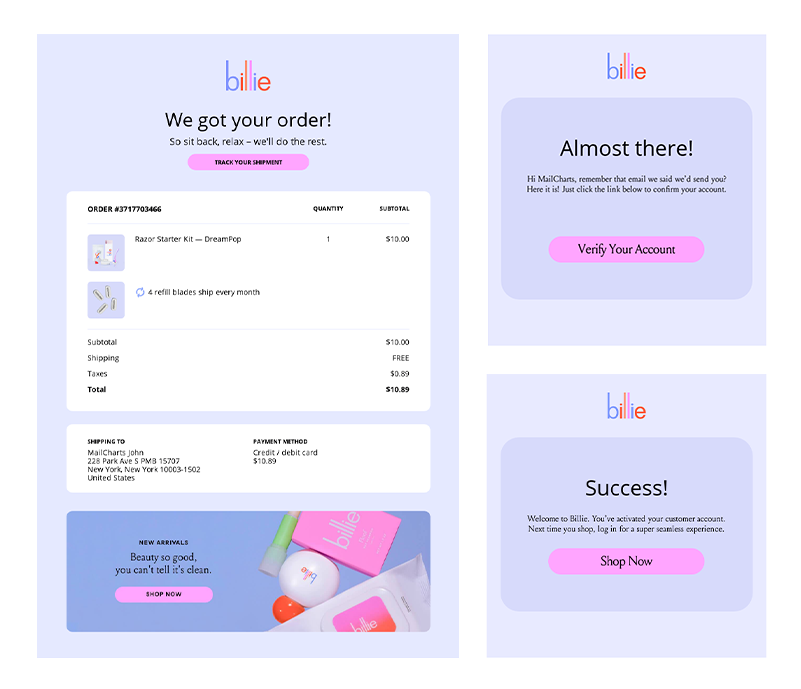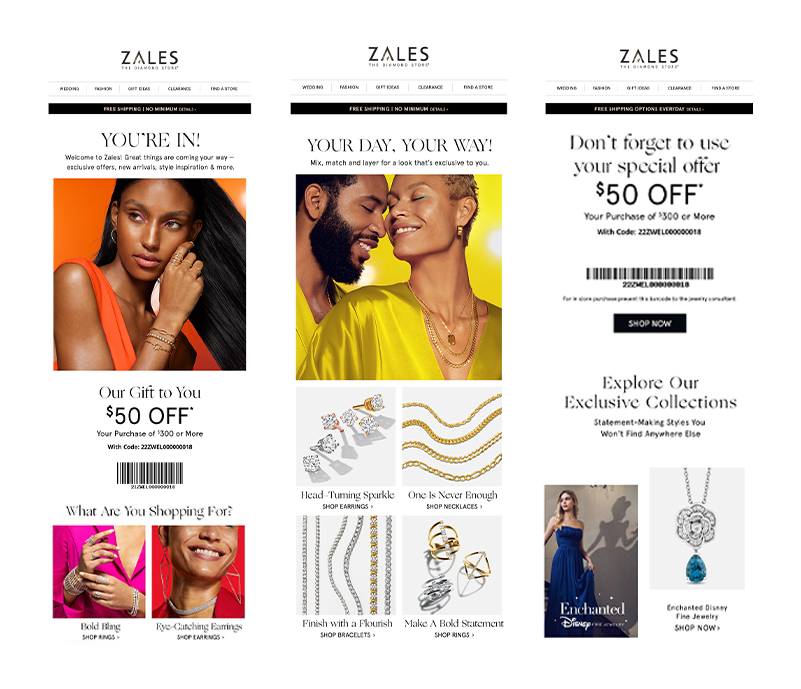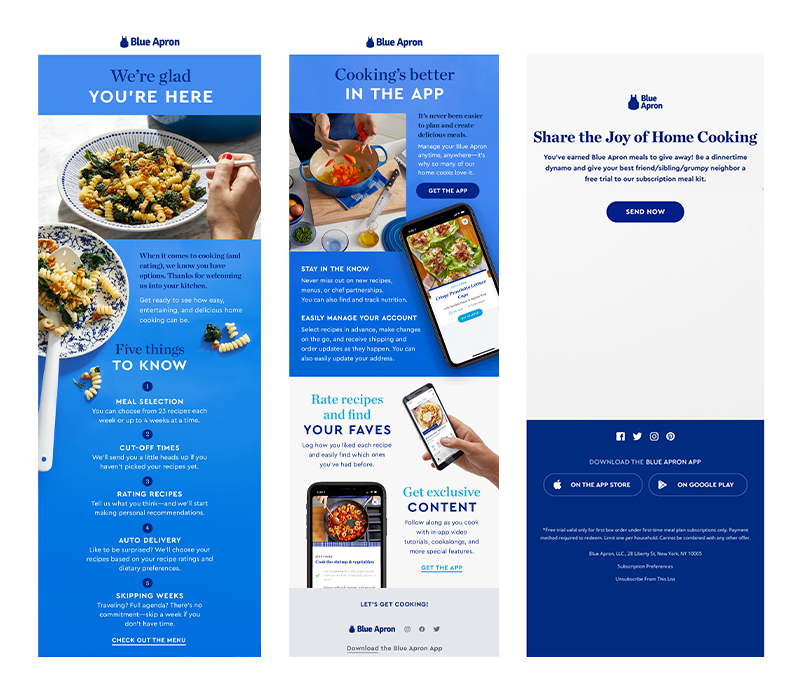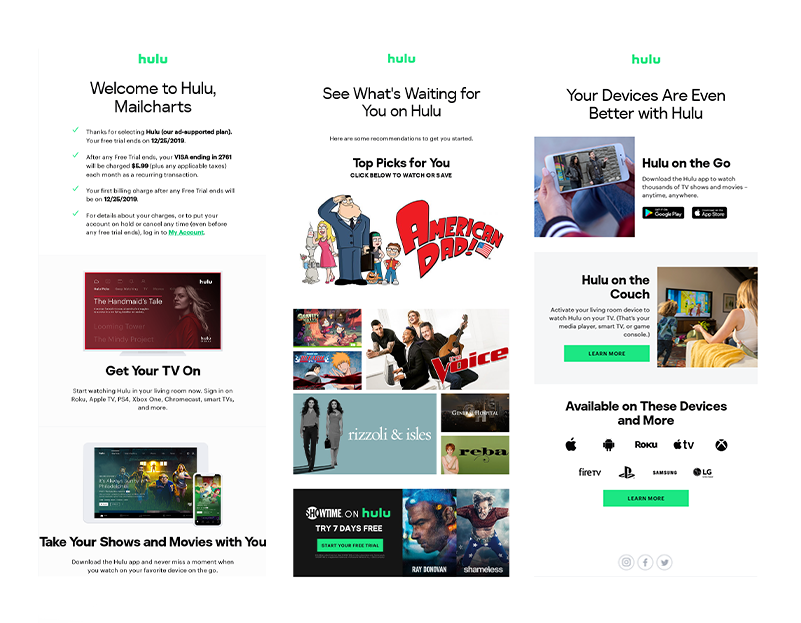Hi! If you’re reading this, you’ve found yourself on the Iterable blog. If you’ve been here before, welcome back. If you’re new, you’re gonna like it here. Our blog is meant to provide you with helpful tips and research that can guide you as you build your marketing strategy. This article, in particular, will explore welcome and onboarding campaigns in a cross-channel capacity.
See that? What you just read? That’s what every welcome and onboarding campaign strives to do—introduce the new user to the brand and set the stage for what’s to come.
In our latest ebook, “Orchestrate Your Cross-Channel Campaigns for Peak Harmonization,” we touch upon a variety of marketing campaigns, including welcome and onboarding, and detail what’s required for each and some tips for building them out. Like we said, this article—the first in a series—will zoom in on welcome and onboarding campaigns to provide more context and examples.
What Are Welcome and Onboarding Campaigns?
Often used synonymously, welcome campaigns and onboarding campaigns are usually the first direct communications your brand has with a customer.
Welcome campaigns often involve a series of messages that are triggered when users first sign up for marketing communications like newsletters, product announcements, etc. They can also be sent after a customer makes a first purchase. Welcome campaigns are great for continued engagement with new customers.
Onboarding campaigns are meant to help users as they become familiar with your product. They’re often triggered when a customer signs up for a membership or logs into an app. Think: product demos, app walkthroughs, user guides, etc. Welcome campaigns can contain onboarding messaging and onboarding campaigns can contain welcome messaging. The two go hand-in-hand.
To execute welcome and onboarding campaigns effectively, there are four key elements you’ll need to consider: purpose, managed expectations, channel expansions, and personalization. Let’s take a look at each.
Finding a Purpose
Welcome and onboarding campaigns generally are not single messages—they’re a series. But, on the flipside of that, you can’t just make a series for the sake of making a series. Each message needs to have a purpose behind it that contributes to the overall experience.
For razor brand Billie, the purpose of their welcome and onboarding series is to get first-time buyers to activate their accounts—streamlining future orders.


Billie wastes no time, ensuring users can easily order more razors—a frequent purchase—in the future. Source: Mailcharts.
It’s very clear from Billie’s welcome and onboarding emails what they want the users’ next step to be. In this case, the customer has already purchased, so, at this point, there’s no need to introduce the brand or share company values.
Managing Expectations
Next, your welcome and onboarding campaigns should manage customer expectations. Sending these initial messages gives you the opportunity to set the tone of your relationship with each customer. Take this time to explain what content is going to come, and what customers can expect as a result of signing up for marketing messages.
Jewelry brand, Zales, clearly set expectations in the first welcome email. As a customer who has just signed up for Zales’ marketing messages, I now know I can expect at least exclusive offers, new arrivals, and style inspiration.


Zales manages expectations by telling customers exactly what content they’ll be sending through this channel. Source: Mailcharts.
Not only did Zales explain what would be coming, they followed through. The first email contains a $50 off coupon, the second email has style inspiration, and the third email reminds the user of their exclusive offer. It’s one thing to set expectations, it’s another to deliver on them.
Expanding Channels
Welcome and onboarding campaigns take advantage of heightened customer engagement. Customers are actively interacting with your brand. Therefore, you should use this time to connect with customers via multiple channels. Email may start the initial conversation, but don’t forget about the other avenues through which you can reach your customers.
Blue Apron, a meal subscription box brand, knows that their app is essential when it comes to their customer experience. As part of their welcome and onboarding campaigns they spotlight the benefits of downloading their app.


Blue Apron wants customers to use both email and their mobile app. Therefore the first email explains how Blue Apron works, and the second email recommends downloading the app. Source: Mailcharts.
Once the app is downloaded, the door is opened for Blue Apron to explore push notifications and in-app messaging. But, having multiple ways to connect with customers means the onus is on the brand to create a seamless, integrated, cross-channel experience.
Personalizing the Experience
Because welcome and onboarding campaigns are sent at the very beginning of a brand’s relationship with the customer, personalization can be tricky. But, what does your brand know at this point? Including the user’s name in the copy or subject line can be a simple, but effective way to personalize your campaigns.
Hulu, the streaming service, added a personalized touch right off the bat. In the very first email to the customer, their name is in the header copy and subject line. The second email in the series offers up some recommendations, likely based on an online profile that the customer filled out.


Hulu is aiming to establish trust with their users by recognizing each as an individual. Source: Mailcharts.
Welcome and onboarding campaigns are also the perfect moment to ask users about their preferences. What kind of content do they want to receive going forward? What products are they the most interested in? With this information in tow, your brand is now equipped to deliver even more personalized content.
Making a First Impression
Welcome and onboarding campaigns are your brand’s first impression. You want to deliver content to new users when they need it the most. Think about how you’d use your product and what content would be helpful in each scenario. Also, remember that you can create a series over an extended period of time. Not everything you want to say matters to the customer so, while you have their attention, boil your messaging down to deliver relevant, timely content. No one likes a long-winded hello.
To learn more about welcome and onboarding campaigns, along with other marketing campaigns, download “Orchestrate Your Cross-Channel Campaigns for Peak Harmonization.”
































